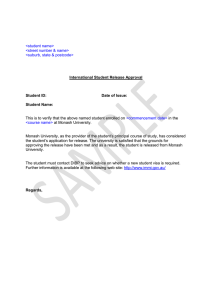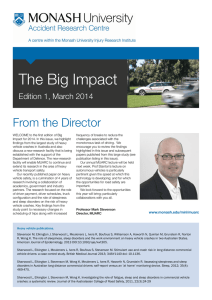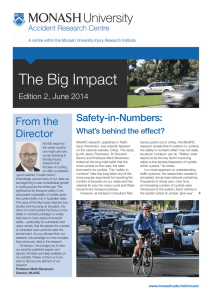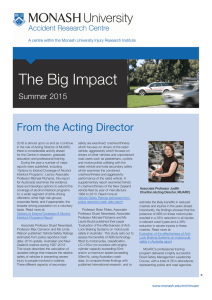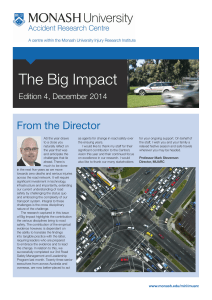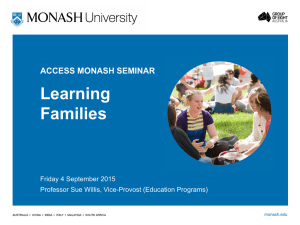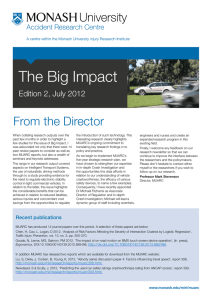The Big Impact From the Acting Director Winter 2015
advertisement
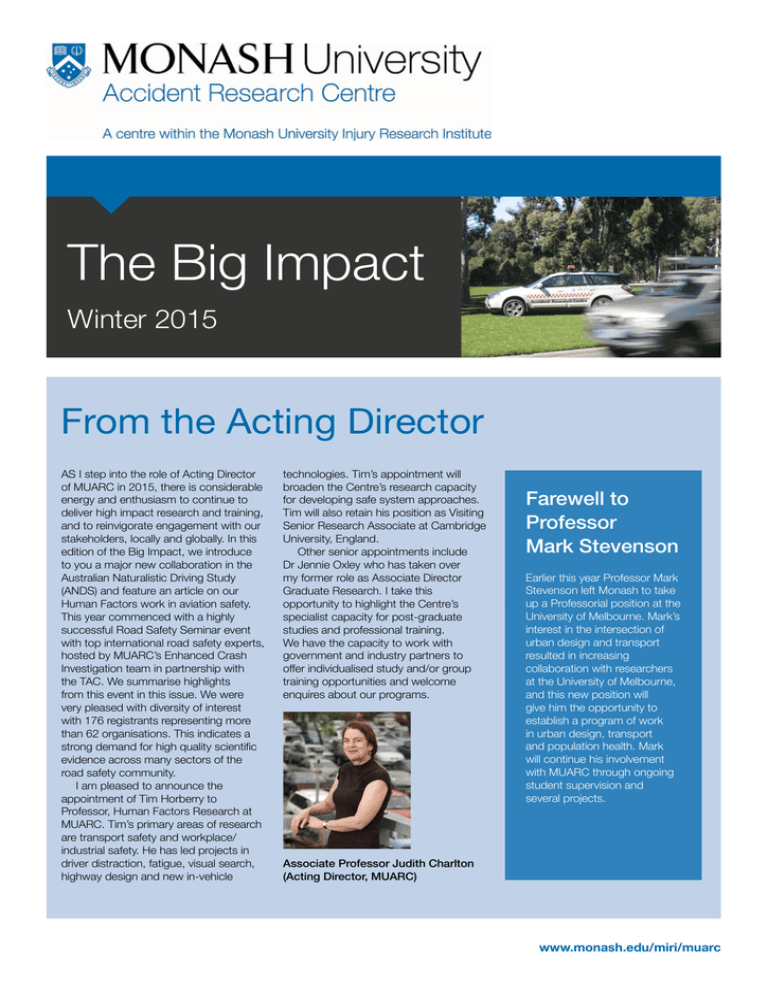
The Big Impact Winter 2015 From the Acting Director AS I step into the role of Acting Director of MUARC in 2015, there is considerable energy and enthusiasm to continue to deliver high impact research and training, and to reinvigorate engagement with our stakeholders, locally and globally. In this edition of the Big Impact, we introduce to you a major new collaboration in the Australian Naturalistic Driving Study (ANDS) and feature an article on our Human Factors work in aviation safety. This year commenced with a highly successful Road Safety Seminar event with top international road safety experts, hosted by MUARC’s Enhanced Crash Investigation team in partnership with the TAC. We summarise highlights from this event in this issue. We were very pleased with diversity of interest with 176 registrants representing more than 62 organisations. This indicates a strong demand for high quality scientific evidence across many sectors of the road safety community. I am pleased to announce the appointment of Tim Horberry to Professor, Human Factors Research at MUARC. Tim’s primary areas of research are transport safety and workplace/ industrial safety. He has led projects in driver distraction, fatigue, visual search, highway design and new in-vehicle technologies. Tim’s appointment will broaden the Centre’s research capacity for developing safe system approaches. Tim will also retain his position as Visiting Senior Research Associate at Cambridge University, England. Other senior appointments include Dr Jennie Oxley who has taken over my former role as Associate Director Graduate Research. I take this opportunity to highlight the Centre’s specialist capacity for post-graduate studies and professional training. We have the capacity to work with government and industry partners to offer individualised study and/or group training opportunities and welcome enquires about our programs. Farewell to FarewellMark to Professor Stevenson Professor Mark Stevenson Earlier this year Professor Mark Stevenson left Monash to take up a Earlier this year Professor Mark Professorial position at the University StevensonMark’s left Monash tointake of Melbourne. interest up a Professorial position at the the intersection of urban design of Melbourne. Mark’s and University transport resulted in increasing interest inwith the researchers intersection of collaboration at the urban of design and transport University Melbourne, and this new resulted in increasing position will give him the opportunity to collaboration with establish a program of researchers work in urban at the University Melbourne, design, transport andofpopulation health. new position will Markand willthis continue his involvement him the opportunity with give MUARC through ongoingtostudent establishand a program of work supervision several projects. in urban design, transport and population health. Mark will continue his involvement with MUARC through ongoing student supervision and several projects. Associate Professor Judith Charlton (Acting Director, MUARC) www.monash.edu/miri/muarc Game changer for road safety About 1300 people die and 33,000 more are seriously injured each year on Australian roads. The subsequent estimated cost of road trauma to the Australian community is about $27 billion a year. MOST evidence about crashes and road trauma comes from data collected after the event by police, coroners, hospitals, and licencing and registration authorities. MUARC is proud to be a leading partner in a ground-breaking new national collaborative study which will use advanced sensors and data logging technologies to study the behaviour of drivers, their cars and other road users in the real world, during every day driving situations. The study is a potential game changer for road safety, and will inform the strategies that will reduce the incidence and impact of injury from crashes on Australian roads. In an Australian-first study into everyday driving behaviour, the $4 million Australian Naturalistic Driving Study (ANDS) will determine how drivers deal with hazards including busy intersections that have no traffic lights and difficult driving situations such as pedestrians unexpectedly crossing the road or other drivers engaging in risky behaviour. Through this research we will learn how people avoid collisions or other safety-related incidents in everyday driving. The study will also reveal new information about human factors such as distraction, inattention, speeding, aggression and tiredness, which are implicated in many collisions. The results will provide critical new insights for improving driver training, 2 www.monash.edu/miri/muarc licensing procedures, and vehicle and road infrastructure design. Volunteer drivers are being sought to participate in the innovative research and have their cars fitted with a Data Acquisition System (DAS) to record their driving over a four-month period. The DAS is a unique system of sensors and dataloggers including video, acceleration in multiple axes, gyroscopic motion, indicator status, speed, radar, and GPS position that allows the continuous recording of vehicleand driver-based data. MUARC will lead the data collection in Victoria, enrolling 180 male and female drivers from Victoria, aged between 20 and 70, who hold a full driver’s licence. A parallel cohort of 180 drivers will be followed in NSW. Associate Professor Jude Charlton heads up the MUARCbased team with project Chief Investigator, Dr Kristie Young, Technical Officers Yik Hue and Andrew Lyberopoulos, and Research Assistant Rachel Osborne. The study is led by UNSW in collaboration with Monash University, Queensland University of Technology, the University of Adelaide and Virginia Tech (USA). Government and industry partners include the Centre for Road Safety at Transport for NSW, NRMA, the Transport Accident Commission in Victoria, VicRoads, the Motor Accident Commission in South Australia and the Western Australian Office of Road Safety. Additionally, Hyundai Australia have donated two cars to the project which will become demonstration vehicles to showcase the study technologies and promote the project. The project receives funding from the Australian Research Council through the Linkage Scheme. More information about the study is at http://ands.unsw.edu.au/ and http://monash.edu.au/miri/research/ research-areas/transport-safety/ australian-naturalistic-driving-study/ MIRI expert helps swing “colour-blind” pilot case A MIRI researcher’s expert evidence has played a key role in a legal ruling that paves the way for pilots with impaired colour vision to become airline captains. THE decision by the Administrative Appeals Tribunal of Australia has set a precedent that a clear safety case must be made, rather than assuming that a person with a disability is incapable of performing a safety-critical task. Associate Professor Geoff Stuart, who works in the Human Factors team, was an expert witness in the three-day case in Brisbane before the Honourable Justice Benjamin. Commercial pilot John O’Brien, pictured right, who has more than 6000 flying hours, appealed to the tribunal after the Civil Aviation Safety Authority (CASA) rejected his request for a class 1 medical certificate to allow him to fly as an airline captain or pilot in command. The tribunal heard that CASA had for years been aware of Mr O’Brien’s colour vision deficiency (CVD) and had, over a number of years, conditionally approved him to fly regular public transport aircraft as a first officer. Under CASA’s previous rulings, pilots with CVD had been unable to progress further than first officer. Mr O’Brien has poor red/green colour vision due to a condition called protanopia, the absence of the longwavelength sensitive pigment in the retina. CASA called several witnesses expert in colour vision and its disorders. After hearing expert evidence from CASA and from Mr O’Brien, Justice Benjamin and Member William Isles said they were satisfied that with the conditions imposed, Mr O’Brien would not be a risk to the safety of air navigation as a consequence of his sight deficiency. The dispute largely rested on CASA making a clear safety case for their refusal to allow Mr O’Brien to undertake the role of captain. CASA did not dispute Mr O’Brien’s competency and accepted he had flown commercial aircraft for many years, without incident. Justice Benjamin said that Mr O’Brien’s ability to operate aircraft was not at issue and his skills were very well regarded by colleagues. In fact, his employer had promoted him to be a flight simulator instructor for both flight captains and first officers. A/Prof Stuart said the case showed that while safety was certainly the absolute priority, regulators had to “make a safety case” in order to avoid workplace discrimination. “I took the position that most MIRI experts do – we look at the whole system, including the human operator,” he said. “CASA’s position, consistent with that of many overseas regulators, is that some aircraft and landing systems employ colour codes and this represents a safety risk in the case of pilots with impaired colour vision. “This does not take into account the fact that many colours can be discriminated in context by such pilots. In addition, there may be other sources of information within a system that allow an operator to conduct a given task safely”. The tribunal accepted Mr O’Brien’s detailed submission that despite his acknowledged colour vision deficiency he had demonstrated his practical ability to safely handle an aircraft. Mr O’Brien’s clearance only applies to flights within Australia, he must fly with a co-pilot at night and he must inform employers and other crew members of his colour vision deficiency. Mr O’Brien says that CASA has not lodged an appeal within the 30 day statutory period. For more information, contact: Geoffrey.stuart@monash.edu www.monash.edu/miri/muarc 3 MUARC and TAC Road Safety Seminar Top international road safety experts and local road safety partners came together at the Annual TAC-MUARC Road Safety Seminar in March. REPRESENTATIVES from state and local government, industry bodies, and research institutes were among the 176 participants at the ‘Innovative Thinking in Reducing Road Trauma’ event at Docklands in Melbourne. In opening the seminar, Acting MIRI Director Professor Lesley Day and Mr Joe Calafiore of the Transport Accident Commission said the seminar aimed to advance thinking in road safety through a safe systems approach incorporating human behaviour, road design and vehicle technology. Presentations at the seminar included: • ‘Development and evaluation of an evidence based parent coaching guide for learner teen drivers’ - Professor Ray Bingham, University of Michigan Transportation Research Institute • ‘Sorry Officer, I wasn’t driving – my car was: Some legal and regulatory implications for automated vehicle technologies and driverless cars’ Associate Professor Diana Bowman, University of Michigan 4 www.monash.edu/miri/muarc • ‘Opportunities for the reduction of serious-to-fatal injuries in vehicle – guardrail collisions’ - Professor Clay Gabler, Virginia Tech • ‘From one-to-many: applying insights from in-depth crash investigations from ECIS to the development of safe systems infrastructure solutions’ Dr Bruce Corben, Corben Consulting • ‘Optimising the post-crash response’ - Professor Russell Gruen, Director National Trauma Research Institute, The Alfred • ‘The Road to recovery: the impact of serious injury and the ‘hidden’ road toll’ - Associate Professor Michael Fitzharris, MIRI A panel discussion, facilitated by Samantha Cockfield (TAC), brought together the presenters and Adjunct Professor Mike Lenné and Professor Mark Stevenson to discuss road safety related topics and answer questions from the audience. Topics addressed included road design for motorbike and bicycle safety, the role of speed in serious injury accidents, education of learner drivers, role and timing of technology advances, reporting of serious injury road toll and some of the technical and legal issues surrounding automated vehicle technology. Developing strategies to provide short-term improvements in road safety while looking for longer-term transformations in vehicle and road system design, were highlighted as critical components of reducing the serious injury and fatal road toll in the future. The seminar was recorded, and an audio and video will be made available to invited guests. TAC Seminar summaries Development and evaluation of an evidence-based parent coaching guide for learner teen drivers C. Raymond Bingham, PhD Professor Raymond Bingham leads the Young Driver Behavior and Injury Prevention group at the University of Michigan Transportation Research Institute (UMTRI), . Professor Bingham explained that teens were at greatest risk of being injured in a car crash in the first months and years of independent driving. In the US, car accidents are the leading cause of death in this age group. Research in numerous countries has shown that crash risk for teenagers is low while driving is supervised by parents, and then skyrockets when the teenage qualifies for an independent or provisional licence. According to Professor Bingham a graduated licensing system – such as Victoria’s Ls (learner permit/supervised licence), P1 and P2 – is effective in reducing crash risk. However the research conducted at UMTRI showed that the driver curriculum could be further strengthened by the addition of driving requirements in a range of different on-road scenarios Professor Bingham’s presentation outlined that parent supervised driving, such as the required 120 hours of supervised driving for Victorian L-platers, as a great opportunity to help teens become safer drivers. However in the US, parents have no guidance nor evidence-based resources, leaving many US parents uncertain how best to help their teens. Professor Bingham currently leads a research project at UMTRI aimed at developing and evaluating a coaching guide for US parents. In the development phase, road safety experts, 21 parents with teens at various licence stages, along with 10 independent parent reviewers, assisted in the development of the guide’s content and presentation. This guide highlighted 3 principles: 1. Start with the simplest, safety driving conditions 2. Progress slowly to more challenging and complex driving conditions 3. Practice driving skills repeatedly and with focus. Graphics (below left) were incorporated to guide driving practice, by highlighting the conditions of low risk driving and those that are more complex and higher risk. During the evaluation phase, this parent guide was tested in the field through naturalistic and survey based assessment. Based on random assignment, some parents were given the parent coaching guide, while others were given the Michigan State Government’s guide for parents. For the naturalistic arm, event-triggered DriveCams were installed in some of the parents’ cars. For the survey based assessment, parents’ were asked to complete three surveys: pretest, at the end of the supervised driving, and three months later. Challenges of the project included budget, recruitment, arranging baseline assessment and an unwillingness to install DriveCams. The evaluation phase is ongoing, but slated to end later this year. ‘Sorry officer, I wasn’t driving – my car was’: Some legal and regulatory implications for automated vehicle technologies and driverless cars Associate Professor Diana Bowman, University of Michigan Associate Professor Bowman looked at issues arising from new autonomous vehicle (AV) technologies. Dr Bowman said the many potential benefits of Level 3 and 4 automation included • a decrease in human error • the potential to reduce the number of crashes, and therefore deaths and injuries, and • reduced congestion on the roads due to ‘connected vehicles’. However there are also potential risks with increasing levels of AV. These include increasing reliance on systems that may fail under certain conditions, lighter www.monash.edu/miri/muarc 5 TAC Seminar summaries continued vehicles that could mean an increase in risks of certain injuries, and environmental concerns due to an increase in the number of vehicles and their emissions. The US is leading the field in AV regulations, with four states already passing laws about testing and/or operation of AVs. The legislation, in general, seeks to define AVs and define the operator. In the US, questions about potential civil and criminal liability are still to be resolved. Associate Professor Bowman pointed out that in Victoria, key questions need to be considered: • Should Victorian policymakers encourage the adoption of AV? • What are the potential implications of a state-by-state approach to their adoption? • What are the infrastructure requirements for AV? • Does the current Victorian regulatory environment allow for fully autonomous vehicles? • Should there be limits on who can own/ operate fully autonomous vehicles? • Will uncertainties regarding potential liability delay the commercialisation of AVs? 6 www.monash.edu/miri/muarc From one-to-many: Applying insights from in-depth crash investigations to the development of Safe System infrastructure solutions Dr Bruce Corben The Safe System Road Infrastructure Program (SSRIP) is the third generation of a TAC-funded, large-scale, safe infrastructure investment programs in Victoria. The program has an ambitious vision of a road transport system free of fatalities and permanent losses of health. The MUARC Enhanced Crash Investigation Study (ECIS) is major TAC funded research program, investigating and collecting data from 400 vehicle accidents in Victoria. ECIS aims to identify and understand the human, vehicle and infrastructure factors leading to serious injury accidents. Dr Corben said there would be many opportunities for ECIS and SSRIP to work together given the programs were investigating mostly the same types of crashes. The SSRIP program’s top priorities were: • Intersection crashes (40% of serious casualties) • Lane departure crashes (35% of serious casualties) • Pedestrian and cyclist crashes (20% of serious casualties). Dr Corben said red-light running was a concerning source of serious casualties at intersections and could be an early example of how ECIS and SSRIP could work together. He said while every crash was unique, outcomes were repeated. The challenge, he said, was to gain a deep understanding from ECIS of contributing factors to crash and injury risk, and to develop generic, affordable and practical solutions. “Innovation and a ‘forgiving’ system are critical to success,” he said. “The benefits can multiply through systemic application.” Opportunities for the reduction of serious injuries in vehicle-guardrail collisions H. Clay Gabler, Center for Injury Biomechanics, Virginia Tech In both the US and Australia, there are many different designs for guardrail. The one characteristic that they all share is to keep drivers who leave the road away from hazards located behind the barrier. When designing these barriers, one concern is that they do not harm. Ideally, a crash into a barrier should be less harmful than a collision with the object behind the barrier. In the U.S. however, there are over 450 fatalities each year involving collisions with guardrail. Professor Gabler posed the questions: what is the nature of this problem and what are the priorities in designing and applying countermeasures? To ensure safety, guardrail systems are crash tested with passenger cars, light trucks, and heavy vehicles. A typical crash test for a passenger car is a 100 km/ hr frontal angled impact into a guardrail system. Professor Gabler asked how relevant these crash tests are to the actual TAC Seminar summaries continued problems being experienced in the real world. Professor Gabler’s research showed that were that nearly half (43%) of all fatalities in guardrail collisions are motorcyclists. For fatally-injured passenger vehicle occupants, 40% experienced either a side impact or a rollover. None of these crash types are the subject of the current NCHRP-350/ MASH/EN-1317 crash tests of guardrails. Professor Gabler asked whether we should consider different, more appropriate guardrail crash tests. In summary Professor Gabler, outlined that the priorities for injury reduction through countermeasures should include: • Motorcycles - motorcycle barrier under ride protection • Side impacts - ESC equipped vehicles and improved side crash designs • Rollovers – higher barriers (increase from 705mm to 800mm) • End terminals – NCHRP-350/MASH/ EN-1317, compliant designs. Optimising the post-crash response Professor Russell Gruen, Director, The National Trauma Research Institute, Professor of Surgery and Public Health, The Alfred Hospital and Monash University Professor Gruen discussed the importance of trauma care, and the history of the Victorian State Trauma System. His presentation included a timeline on road trauma deaths in Victoria from 1952 until 2013, including the introduction of • Compulsory seatbelt legislation in 1970 • Random breath testing in 1976 • Red light cameras in 1983 • Mobile speed cameras in 1989 • Booze buses in 1990 • Fixed speed cameras in 2000 • Random drug testing and impounding of hoons’ cars in 2006 The Victorian State Trauma System was implemented in 2001, aiming to deliver the patient to the right hospital as quickly as possible, and to best match resources with patients’ needs. The system was born out of a ministerial review and bipartisan political, professional and public support. Professor Gruen said that today the system was moving towards higher performance • using failsafe systems • looking to long-term outcomes, non-mortality recovery, and system outcomes • listening to patients’ voices on disability and providing personalised medicine • expediting interventions and pre-hospital care • advocating for trauma care, and • the best equitable care for low and middle income countries. The road to recovery: the impact of serious injury and the ‘hidden road toll’ Associate Professor Michael Fitzharris Associate Professor Michael Fitzharris argued that the community needed a greater understanding of the scale and impact of serious injuries from road crashes. His presentation showed that media coverage focused on deaths on the roads and questioned if this left serious injuries as an ‘unspoken, invisible epidemic’. Associate Professor Fitzharris explained that the impact of serious injury from road trauma went far beyond hospitalisation and rehabilitation. Serious injury from road trauma could result in PTSD, depression, travel phobia, pain, high alcohol consumption as well as social impacts including financial difficulties, limits on family, leisure and work options, and discrimination. He presented the scenario of a driver who ran into a pole, resulting in injuries including concussion, collapsed lung and internal chest injuries, multiple fractures, and a psychological reaction. The consequences of the injury are immense, including • Impairment - limping, permanent scarring, depression and thoughts of self-harm, anxiety • Resource use – air ambulance, hospitalisation • Loss of quality of life – stops running his business, starts gambling, withdraws socially • TAC compensation costs of up to $750,000 • Threat to life, with 50% chance of death • Pain and suffering, including marital separation. Associate Professor Fitzharris said road safety needed to be seen as an investment in people and a societal obligation. He said that government needed ‘courageous patience’ to truly make a difference. “As a civil society, we can no longer ignore the suffering experienced by people seriously injured,” he said. ‘So our challenge is to start a conversation about ‘serious injury’ with the whole community.” www.monash.edu/miri/muarc 7 Below are MUARC publications this quarter: Candappa, N., Logan, D., Van Nes, N., Corben, B., 2015, An exploration of alternative intersection designs in the context of Safe System, Accident Analysis and Prevention, 74, pp 314-323 Fitzharris M, Cripps R A, Lee B B. Estimating the global incidence of traumatic spinal cord injury. Spinal Cord. 2014; 52, 117–122. Hughes, B.P., Newstead, S., Anund. A., Shu, C.C., Falkmer, T., 2015, A review of models relevant to road safety, Accident Analysis and Prevention, 74: 250-270 Koppel, S., Kuo, J., BereckiGisolf, J., Boag, R., Hue, Y.-X., Charlton, J.L., 2015, Examining Physiological Responses Across Different Driving Maneuvers During an On-road Driving Task: A Pilot Study Comparing Older and Younger Drivers, Traffic Injury Prevention, 16:3, pp 225233 Lansdown, T.C., Stephens, A.N., Walker, G.H., 2015, Multiple driver distractions: A systemic transport problem, Accident Analysis and Prevention, 74, pp 360-367 Lee B B, Cripps R A, Fitzharris M, Wing P C. The global map for traumatic spinal cord injury epidemiology: Update 2011, global incidence rate. Spinal Cord. 2014,52:110–116 McClure R J, Adriazola-Steil C, Mulvihill C, Fitzharris M, Bonnington, C.P, Salmon P, Stevenson M. Simulating the dynamic effect of land use and transport policies on the development and health of populations. Submitted to the American Journal of Public Health. 2015; 105 (S2), S223-S229. Meredith L, Baldock M, Fitzharris M, Brown J. Pelvic Injury Mechanisms among Motorcyclists [short communication]. IRCOBI Conference Proceedings 2014. Newman, S., Goode, N., 2015, Do not blame the driver: A systems analysis of the causes of road freight crashes, Accident Analysis and Prevention, 76, pp 141-151 Read, G.M., Salmon, P.M., Lenne, M.G., 2015, Cognitive work analysis and design: current practice and future practitioner requirements, Theoretical Issues in Ergonomics Science, 16:2, pp 154-173 Rizzi, M., Strandroth, J.,Kullgren, A., Tingvall, S., Fildes, B., 2015, ‘Effectiveness of Motorcycle Antilock Braking Systems (ABS) in Reducing Crashes, the First Cross-National Study, Traffic Injury Prevention, 16:2, pp 177183 Savino, G., Rizzi, M., Brown, J., Piantini, S., Meredith, L., Albanese, B., Pierini, M., Fitzharris, M., 2014, Further Development of Motorcycle Autonomous Emergency Braking (MAEB), What Can In-Depth Studies Tell Us? A Multinational Study, Traffic Injury Prevention, 15:sup1, S165-S172 Thai, K.T., McIntosh, A.S., Toh Yen Pang, 2015, Bicycle Helmet Size, Adjustment, and Stability, Traffic Injury Prevention, 16:3, pp 268-275 Thompson, .J, Savino, G., Stevenson, S., 2015, Reconsidering the Safety in Numbers Effect for Vulnerable Road Users: An Application of Agent-Based Modeling, Traffic Injury Prevention, pp 147-153. Further information Monash University Accident Research Centre (MUARC) Building 70, Clayton Campus Monash University, VIC 3800 Telephone: +61 3 9905 4371 Email: miri-enquiry@monash.edu 8 www.monash.edu/miri/muarc
